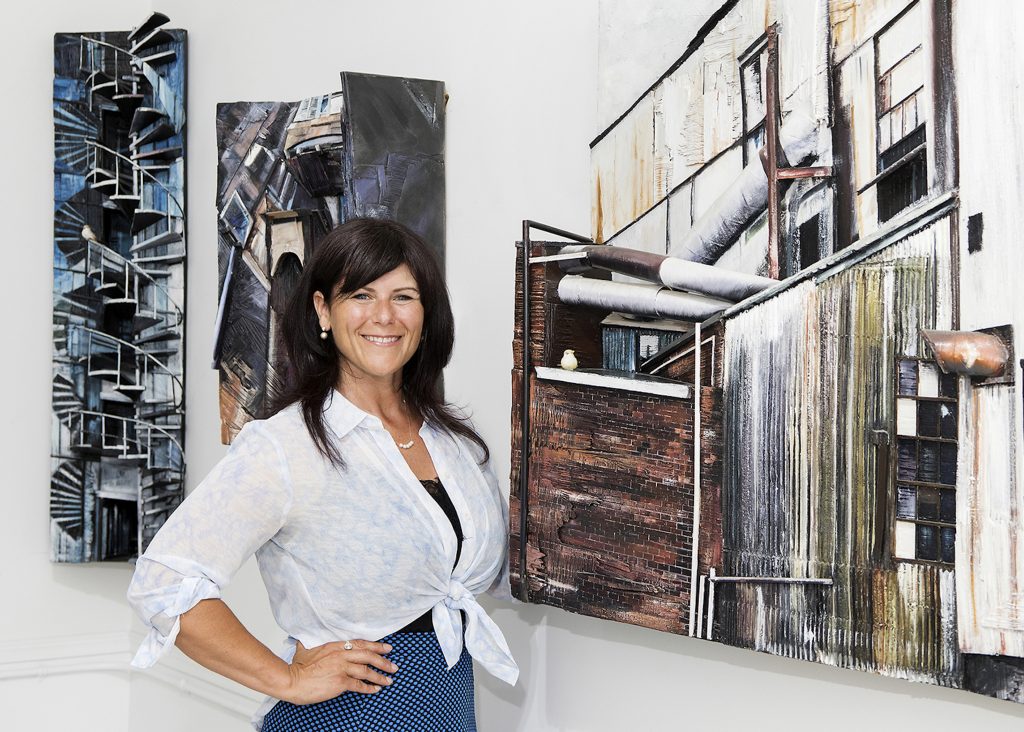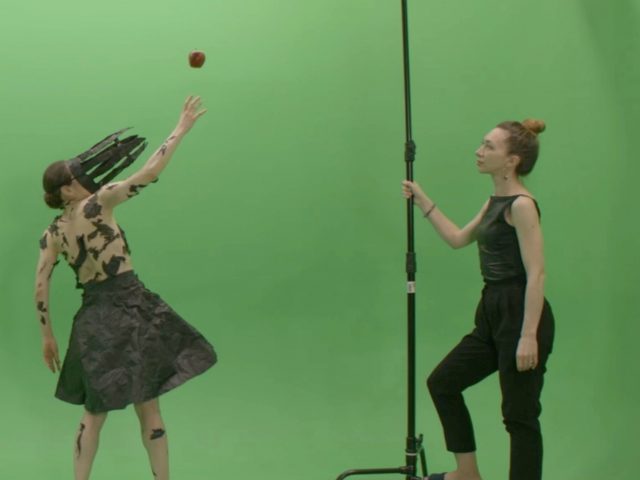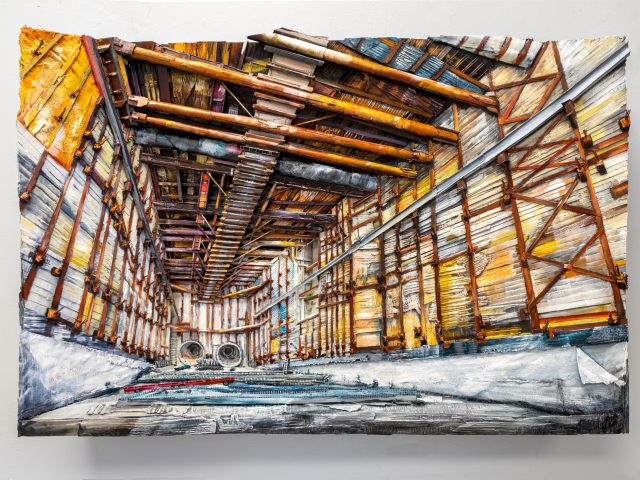Architecture of the Soul with Artist Heather Kocsis
For over 20 years, artist Heather Kocsis has created art with the language of architecture to enrich private and public spaces with work that extends beyond the physical. Sacred geometry, the patterns found in nature, speak to observers on the level of embodiment. The spiral of a nautilus, the branch of a tree; forms and patterns are endowed with a spiritual meaning that echoes in our built environment, connecting us to foundations of balance and harmony.
In Heather’s work, these principles are embedded in architectural relief and painted environments, creating psychological spaces with physical resonance. The assemblages use densely layered wood, shaped gesturally. Grains act as brushstrokes. Layers of oil paint give life, depth, and motion to the underlying materials. Machined elements provide order and balance to an original creative process, fit to convey complex dimensions like time, change, and emotion.
Kocsis began her artistic career as a printmaking student at Queen’s University (Ontario, CA). She applied complex, layered techniques in etching, screen-printing, and lithography to represent subjects of memory and history. In her second year, she studied abroad in Italy. An experience with Florence Cathedral left on the artist a significant, visceral impression of being in a highly-crafted space made by human hands, though seemingly beyond them. This thread eventually led to her pursuits in sculptural painting, making consciousness-raising contemplative work, a hybrid space between architecture, sculpture, and image.
The transition to wood as a medium came soon after graduation, as Kocsis found herself preparing for a group show. Without access to printmaking facilities, she was working in painting and drawing, when a synchronous insight led her to match the texture of brick in a photo to the wood scrap on the floor. She began to tear the wood and cut it apart, recreating the image. The rest, as they say, is history. Her first solo show in 2001 included 14 assemblages and was bought out entirely by a private collector. Since then, her work has been seen at over 50 exhibits in North America.
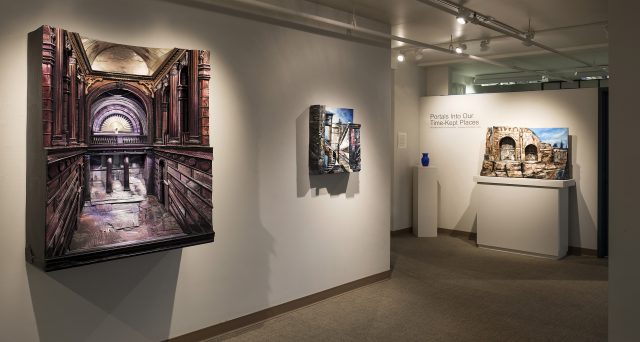
In the beginning, the buildings Kocsis represented were not grand, but recognizable in the community. Buildings that had heart. People of all ages and demographics are attracted by the intricacy of the technique and the subject’s relatability. Across the world, people are drawn to churches, ruins, and sites that hold the energetic resonance of the past. Kocsis’s interest in how other cultures respond to place is fueled by travel, drawing the world’s magic back to her studio.
Over time, subjects evolved from facades to include interiors, following insight from the artist’s spiritual practice. She says, “The more I uncover in my life, the more I let go, the more it connects me deeper to myself, to other people, and to our relationships.” Her most recent works feature architectural entrances, or portals, suggesting transition. She envisions work like “Peace Profound” and “Spiraling Light” residing in households and healthcare settings, aiding those at the end of life as a meditative safe space for processing our return.
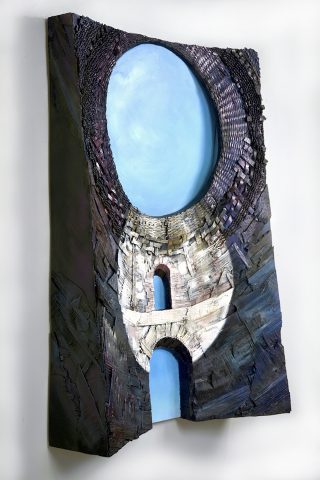
With skill, expertise, and sensitivity, Heather captures the lives and stories embodied in our homes, workplaces, skyscrapers, museums, and temples. With each creation, she reminds us of our own sense of home and our connection to community. Kocsis creates only one piece at a time to invest the whole of her practice into making the highest impact, treating the client’s hopes and desires for the piece as if her own.
In recent years, this work has expanded to include international multi-media collaboration, with Heather’s sculpture being used as “sets” for performance works. In a series of five short films, “Dancing Within Our Worlds” offers distinctive narratives that build off psychic, historic, and emotional spaces. These “spaces” have been built by Kocsis in a reflexive process with the other artists and film-maker, fleshing out a touching range of personal stories. The emotive journeys of the dancers embody the fullness of potential held in Kocsis’s sculptural worlds. Green-screen technology allows the dancers to physically inhabit the work as psychopomps, transcribing messages between worlds, real and imagined.
In “Red Tree”, choreographed and danced by Lidia Kopina, Kocsis recreates the dancer’s torched childhood home in Russia. Today a single apple tree grows among the ruins. In half of the home, Kopina dances the light side of her memoryscape, through gauzy warm hues, capturing light to make shadow puppets. Passing through a threshold, her erratic movements echo the crackle of fire in a room already burned. Like a phoenix, the dancer is ultimately transformed.
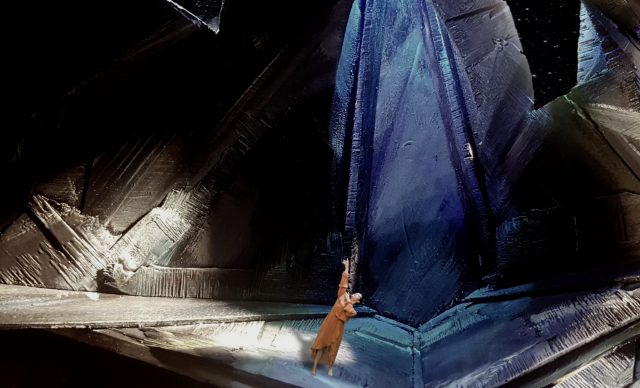
Also from the series, in “Rage Against Violence”, dancer Gisel Sahari Vergara Herrera tells the story of the disappearance of her friend’s mother. The space created by Kocsis is made with rough grain, cool colors, and slanted architecture, absurd and tunnel-like suggesting the inner life of trauma. The deconstructed, tilted floors shape bodies in a fight for balance, constrained by gravity, abject and alive, vulnerable and victimized. Herrera dances to rain, wind, and spoken word, exploring love, violence, and the cultural history of femicide. While the inner retreat may be dark, the outside of the sculpture is inspired by ceramic and the stone labradorite. The process of “golden repair” uses precious metal to mend broken pottery, suggesting the value of the restorative work that makes space for all the darkness and light life must hold.
Kocsis says, “Architecture is my metaphor to connect with people on a soul level.” Just as the body is the temple for the soul, the architecture around us gives shape to our energetic expression. People commission Kocsis to create pieces of what home feels like to them, so they can access at any time the feelings of safety and elevated perspective it offers. Beyond metaphor, Kocsis’s tactile, painterly, and commanding objects inspire new worlds of hope and potential.
https://www.heatherkocsis.com/
